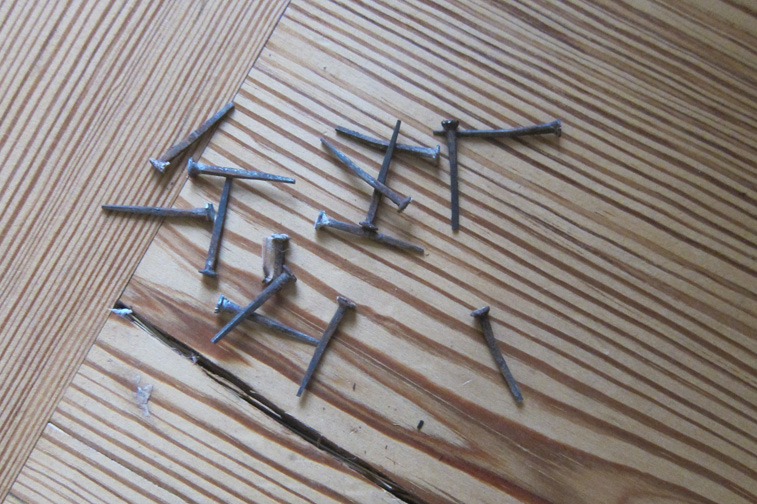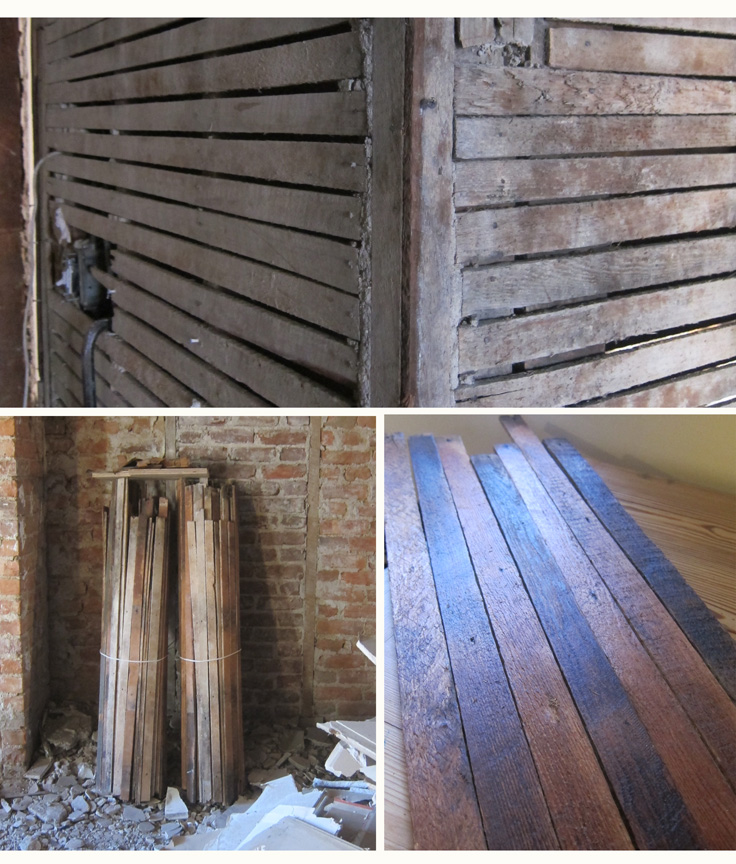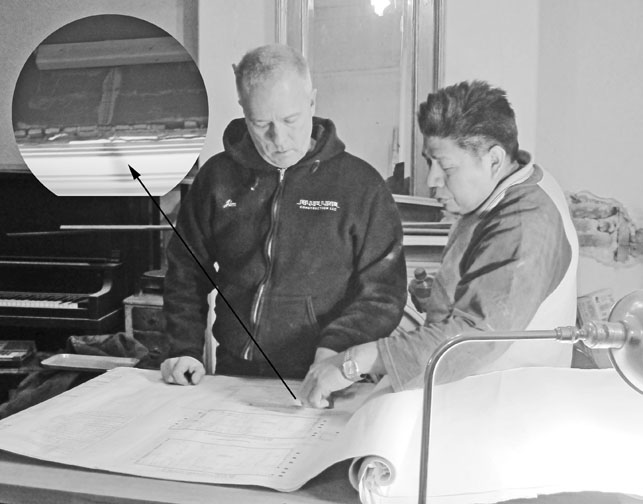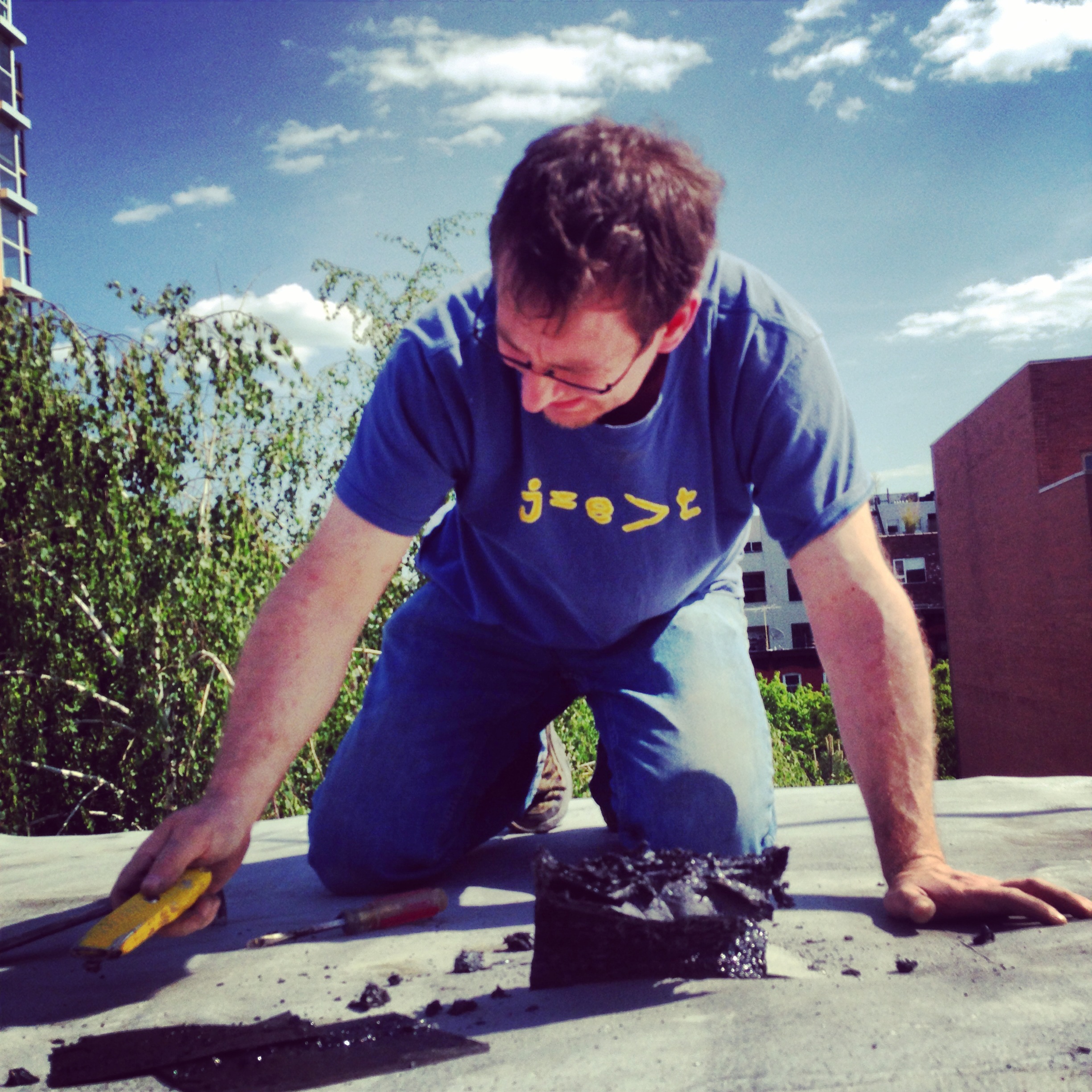A first encounter in the Passive House renovation – old party walls rise like a funhouse mirror. Here, Jim Hartin and Sal Rodriguez of Blueline Construction work on an approach. The painted line in the floor joist (upper left image) was marked in a direct vertical line at each floor, providing a consistent reference relative to the changing distance to the party wall.
brooklyn
Rolling out the Bklyn Warehouse
 The bin build out at the Brooklyn warehouse (71 Troy Ave.) is being completed. The innovative system utilizes salvaged conveyor rollers from Pennsylvania and reclaimed dimensional lumber (3 x 10’s) from the city within a conventional lumber storage grid, allowing visitors to pull stacks of wood into an open area for sorting.
The bin build out at the Brooklyn warehouse (71 Troy Ave.) is being completed. The innovative system utilizes salvaged conveyor rollers from Pennsylvania and reclaimed dimensional lumber (3 x 10’s) from the city within a conventional lumber storage grid, allowing visitors to pull stacks of wood into an open area for sorting.
Reclaimed nails
 The reclaimed wood wall strips in the house were fastened with small nails. Like the Muir Web, where tiny creatures are essential building blocks of nature, this hardware item, barely longer than an inch, held together the built environment of 19th c. New York. Square edged and tapered, they’re a scaled down version of nails used for larger lumber. Often called ‘Class B Cut’, they combine the machine and hand made, chopped at an angle from a metal sheet, with a head formed from a quick strike to a heated end. They came in the millions from the iron belts of Birmingham or Sheffield, England or western Pennsylvania during the industrial era. Where they’ll go next is uncertain. (photo: nails on Longleaf Pine)
The reclaimed wood wall strips in the house were fastened with small nails. Like the Muir Web, where tiny creatures are essential building blocks of nature, this hardware item, barely longer than an inch, held together the built environment of 19th c. New York. Square edged and tapered, they’re a scaled down version of nails used for larger lumber. Often called ‘Class B Cut’, they combine the machine and hand made, chopped at an angle from a metal sheet, with a head formed from a quick strike to a heated end. They came in the millions from the iron belts of Birmingham or Sheffield, England or western Pennsylvania during the industrial era. Where they’ll go next is uncertain. (photo: nails on Longleaf Pine)
Tiny wall strips
 Reclaiming wood structural joists from row houses in the city can sometimes be a long shot, accounting for the lower volume of material (than industrial bldgs), lack of on site storage and other issues. So it’s rare to salvage even smaller members – interior wall studs and in this case, the finer wall stripping – from the wreckage. Blueline Construction was able to soften the demo touch just enough to pry out the 135 yr old wood strips, largely in-tact.
Reclaiming wood structural joists from row houses in the city can sometimes be a long shot, accounting for the lower volume of material (than industrial bldgs), lack of on site storage and other issues. So it’s rare to salvage even smaller members – interior wall studs and in this case, the finer wall stripping – from the wreckage. Blueline Construction was able to soften the demo touch just enough to pry out the 135 yr old wood strips, largely in-tact.
These woods possess some unique qualities that are welcome salvage for re-use in the house. For one, the aged softwoods are ready-made paneling – milled to 3/8″ and with old finishing nails that are easily tapped out. They also produce a range of natural brown tones, fine saw marks and the rhythm of small nail holes that add to their appeal. Cleaned and potentially waxed or oiled, the narrow boards produce a pin stripe effect against the rustic woods.
Scrapwood Derby
Get the Asbestos Out
Danny O’Connell of OMC Construction takes a roof sample that indicates asbestos within one of the layers – needing removal in advance of the general construction.
Squib history: The chrysotile used for asbestos was first mined in Canada during the 1870’s – and there’s actually a town called called Asbestos, Quebec. The material would become widely used for insulation, drywall, flooring, roofing, ship building and furniture. As early as the first century AD, Greek and Roman slaves had become seriously ill after working with asbestos in weaving. Like switching off coal in favor of solar, insulation has had a long way to go towards removing toxicity and improving insulating quality.





